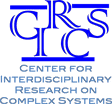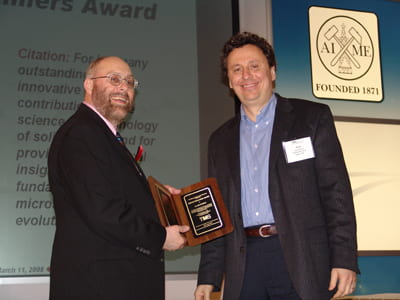News
Paul Champion received the Lifetime Achievement Award at the 2021 International Conference on Time Resolved Vibrational Spectroscopy
The International Conference on Time Resolved Vibrational Spectroscopy (TRVS) celebrated 40 years of bi-annual meetings in 2021. The most recent conference took place using an online format and the scientific program along with related information about TRVS can be found here: www.trvs2021.org. TRVS has elected a recipient for its “Lifetime Achievement Award” for the past 28 years and this year’s Award was presented to Physics Professor Paul Champion at Northeastern University. The list of past award recipients can be found here.
The “TRVS Lifetime Achievement” award is presented to research scientists who are highly recognized leaders in the field for developing ultrafast spectroscopy of molecular systems, particularly molecular vibrations providing information about dynamical structures, photochemical processes, catalysis, and energy transfer. This is an elected award and nominees are typically selected who have demonstrated the highest academic achievements in their subfields of Time-Resolved spectroscopy and who have a strong record of participation at TRVS conferences. The award citation for Professor Champion reads: “For Outstanding Contributions and World-Wide Recognition for Developing novel Time-Resolved Raman Spectroscopies to Measure Complex Phenomena in Biological Systems”.
Alain Karma received Bruce Chalmers Award
CIRCS director Alain Karma is awarded the 2008 Bruce Chalmers Award by TMS (The Minerals, Metals & Materials Society) for his interdisciplinary work at the interface of physics and materials science. Award citation: “For his many outstanding and innovative contributions to the science and technology of solidification and for providing exceptional insight into the fundamentals of microstructure evolution”. Bruce Chalmers Award: The Bruce Chalmers Award was established in 1989 by the Materials Processing & Manufacturing Division of TMS and is named for Bruce Chalmers, widely acknowledged as the father of modern solidification science. The award recognizes outstanding contributions to the field of solidification science.
Professor Dagmar Sternad awarded an NIH grant
In Fall 2010, Professor Dagmar Sternad was awarded a $1.6M grant from the National Institutes of Health to investigate how humans acquire and control sensorimotor skills–the ability to coordinate sensory experiences, such as seeing and hearing, with physical actions.
For more information, see
http://www.northeastern.edu/news/stories/2010/09/sternad_research.html
Armen Stepanyants receives grand prize in DIADEM challenge
On September 2nd, 2010, Professor Armen Stepanyants was among a handful of scientists to receive a grand prize in the DIADEM challenge, an international scientific contest launched in April 2009 and organized by the Allen Institute for Brain Science, the Howard Hughes Medical Institute (HHMI), and the Krasnow Institute for Advanced Study at George Mason University. To merit a grand prize, a successful computational approach should accurately trace neuronal morphology at least 20 times faster than scientists could accomplish the same task by hand. The jury awarded a grand prize to Professor Stepanyants “for the better overall biological results in the spirit of pure automation.”
Williams to become member of the NIH MSFC Study Section
Mark C. Williams has been appointed a regular member of the Macromolecular Structure and Function C Study Section in the NIH Center for Scientific Review, for the term beginning July 01, 2011 and ending June 30, 2017. According to a letter from the Center for Scientific Review, members are selected on the basis of their demonstrated competence and achievement in their scientific discipline as evidenced by the quality of research accomplishments, publications in scientific journals, and other significant scientific activities, achievements and honors. Membership on a study section represents a major commitment of professional time and energy as well as a unique opportunity to contribute to the national biomedical research effort. Study sections review grant applications submitted to the NIH, make recommendations on these applications to the appropriate NIH national advisory council or board, and survey the status of research in their fields of science. These functions are of great value to medical and allied research in this country.
Profs Karma and Upmanyu have been awarded a 3 year $480,000 NSF grant starting September 1, 2011 to investigate fundamental mechanisms of nanocrystalline growth
The goal of this project is to develop scale-bridging computational approaches to understand the interplay between growth morphology, chemistry, and functional properties of semi-conductor nanowires used for a wide range of materials applications from nanoelectronics to solar energy harvesting.
Williams lab awarded $950,000 NSF grant to probe single molecule DNA-ligand interactions
The goal of this new project is to develop single molecule methods for the quantitative study of DNA interactions with small molecules and proteins and to use these methods to investigate specific biologically important systems. The CIRCS Associate Director Mark Williams and co-PI Megan Nunez from Mount Holyoke College will use several DNA constructs and data analysis methods to probe the thermodynamics and kinetics of DNA-ligand interactions and determine the time-dependent changes of DNA structure as proteins and small molecules bind. In addition to method development, this work will shed light on the fundamental biophysics of DNA-small molecule interactions as well as the biophysical and biochemical mechanisms of multiple protein interactions involved in retrotransposon replication and DNA damage response. The three specific aims of this project include probing the structural dynamics of DNA-small molecule interactions using single molecule force spectroscopy, studying dynamic protein-DNA interactions important for LINE1 retrotransposition, and investigating the protein-protein and protein-DNA binding interactions that participate in the management of DNA polymerase switching in E. coli. The total grant amount is $950,000 over 5 years, beginning March 1, 2013.
MIE Associate Professor Sandra Shefelbine, Assistant Professor Randal Erb & Physics Professor Alain Karma awarded a 3 year $445K NSF grant starting Fall 2015 to understand the origin of higher fracture toughness of biological materials and try to recreate it with synthetic components
This collaborative project grew out of a May 2013 CIRCS seminar of Professor Shefelbine entitled Multi-scale mechanics and mechano-adaptation in bone! Toughness is a material’s ability to withstand fracture. Understanding and predicting this key property remains a major challenge for most structural materials. In biological systems high toughness is commonly associated with composite microstructures. Often, soft flexible proteins are found in combination with a hard mineral crystal, organized with specific orientations. This project combines computational and experimental studies of crack propagation to determine the relative importance of material anisotropy and heterogeneities in crack path selection and fracture toughness. Novel synthetic discontinuous fiber composites will be produced whereby inhomogeneity and anisotropy of the composite can be tuned with a magnetic field. Numerical simulations will employ the phase field method to predict complex crack paths in materials with defined anisotropy and heterogeneities. Crack propagation will be experimentally measured and computationally predicted in various loading configurations. The interaction of cracks with macroscopic heterogeneities, and crack growth in anisotropic materials will be investigated. With this research we can determine what type and amount of anisotropy (elastic moduli versus fracture energy) lead to crack destabilization, how these instabilities manifest for different modes of fracture in two and three dimensions, and what relative importance anisotropy and heterogeneity have in promoting crack deflection and increased toughness.
Mapping Circuits in the Brain
In Fall 2015 the Neurogeometry Lab of Prof. Armen Stepanyants at the Department of Physics, in collaboration with the BIG-DATAbase group of Prof. Mirek Riedewald at the College of Computer and Information Science, was awarded a 5 year NIH grant to develop software for accurate, automated reconstruction of structure and dynamics of large neural circuits.
Alain Karma awarded the John Hunt Medal
The Institute of Materials, Minerals and Mining (IOM3) awarded the 2016 John Hunt Medal to Professor Alain Karma for his outstanding contributions to alloy solidification research. The award citation notes that “Alain’s insight into statistical and nonlinear physics has allowed him to solve some of the major problems of the development of solidification microstructures. He has also substantially contributed to the development of mathematical techniques for this kind of highly non-linear problems and specifically to the foundations of the today much used phase field method.”
Alain is scheduled to give the John Hunt Memorial lecture at the upcoming 6th Decennial International Conference on Solidification Processing 25th-28th July 2017, Beaumont Estate, Old Windsor, UK.
More information about the award can be found at: http://www.iom3.org/iom3-awards-2016#16%20achievement

